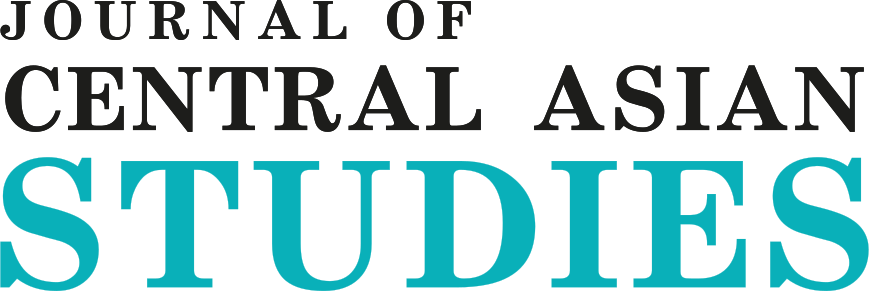Перифериядан әріптестікке: Моңғолияның Орталық Азияға бағытталған сыртқы саясатындағы күшейіп келе жатқан үрдістері
DOI:
https://doi.org/10.52536/3006-807X.2025-3.001Кілт сөздер:
Моңғолия, сыртқы саясатты жандандыру, Моңғолия-Орталық Азия қатынастарыАңдатпа
Моңғолияның сыртқы саясаты дәстүрлі түрде өз көршілері мен «үшінші көршілері» арасындағы тепе-теңдікті сақтауға бағытталды, дегенмен 1990-жылдардың басында Орталық Азия мемлекеттерімен дипломатиялық қатынастар орнағаннан кейінгі бірнеше онжылдық бойы оның байланысы шектеулі болып қала берді. Алайда соңғы жылдары Моңғолия Орталық Азия елдерімен ынтымақтастығын жандандыра түсті. Бұл жаңа елшіліктердің ашылуынан, жоғары деңгейдегі сапарлардан және қарым-қатынастардың стратегиялық әріптестік деңгейіне көтерілуінен көрініс табуда.
Бұл зерттеу осы өзгерістің қозғаушы күштері мен салдарын талдайды. Конструктивистік тұрғыға сүйене отырып, халықаралық қатынастардың либералдық теориясымен толықтырылған бұл зерттеу тарихи шолу, құжаттар мен баяндамаларға талдау, сондай-ақ Моңғолияның Қазақстан, Қырғызстан, Өзбекстан, Түрікменстан және Тәжікстанмен байланыстарының салыстырмалы зерттеулерін қамтиды.
Зерттеу нәтижелері Моңғолияның жанданған қадамы тек қана стратегиялық және экономикалық мүдделермен шектелмей, сонымен бірге мәдени жақындық пен ортақ аймақтық бірегейліктен де туындайтынын көрсетеді. Зерттеу Моңғолияның Орталық Азиядағы шеткері бақылаушыдан аймақтық ынтымақтастықтағы пікірлес серіктеске айналып келе жатқанын алға тартады. Осы трансформацияны мүмкін еткен факторларды айқындай отырып, мақала Еуразиядағы шағын мемлекеттердің дипломатиясы мен өңірлену үдерістеріне қатысты кеңірек пікірталастарға үлес қосады.
Әдебиеттер тізімі
Absametov, M. K., Murtazin, Ye. Zh., Osipov, S. V., & Sapargaliyev, D. S. (2019). Assessment report on classification of energy and mineral resources and its management in the Republic of Kazakhstan. Kazakh National Research Technical University, Institute of Hydrogeology and Geo-ecology.
Akhmetuly, B. (2018). Fifth Caspian Summit: Will an agreement on the status of the sea be signed? Informburo. https://informburo.kz/kaz/besnsh-kaspiy-sammit-tezd-mrtebes-turaly-kelsmge-ol-oyyla-ma.html
Burnashev, R., & Chernykh, I. (2013). Regional conflict: Scenario for Central Asia. Central Asia’s Affairs, 50(1), 44–57. https://jcas-journal.com/index.php/jcas/issue/view/48/47
Central Archives of the Ministry of Foreign Affairs of Mongolia. (2015). Materials related to Mongolia–Kazakhstan relations: 1991–2015 [Archival materials, in Mongolian]. Ministry of Foreign Affairs of Mongolia.
Dorjpalam, E., & Purevdorj, B. (2022). Security issues in Central Asia. Central Asian geopolitics. Institute for Strategic Studies.
Dynkin, A. A., & Baranovsky, V. G. (2013). Challenges to security in Central Asia. IMEMO RAN. https://www.imemo.ru/publications/info/vizovi-bezopasnosti-v-tsentralynoy-azii
E+E Leader. (2025). The role of Caspian energy in global supply chains. https://www.environmentenergyleader.com/stories/the-role-of-caspian-energy-in-global-supply-chains,64169
HKTDC Research. (2024). Central Asia: Market profile. https://research.hktdc.com/en/article/MTg3NDk4Mzg1OA
Institute for Strategic Studies of Mongolia. (2022). Central Asian geopolitics. ISS. National Security Council of Mongolia.
International Monetary Fund (IMF). (2024). Republic of Kazakhstan: 2023 Article IV Consultation — Press Release; Staff Report.
International Trade Center. (2025). Trade Map. Trade statistics for international business development: Monthly, quarterly and yearly trade data. Import & export values, volumes, growth rates, market shares, etc.https://www.trademap.org/Index.aspx
Islamic Development Bank (IsDB), Asian Development Bank (ADB). (2024) Kazakhstan’s resource economy diversification through global value chains. A Co-publication of the Asian Development Bank and the Islamic Development Bank. https://www.adb.org/sites/default/files/publication/1000726/kazakhstan-resource-economy.pdf
Jargalsaikhan, M. (2012). Factoring Mongolia’s non-membership in the Shanghai Cooperation Organisation. Voices from Central Asia.
Jargalsaikhan, M., Nyamjav, S. (2022). Mongolia’s New Foreign Policy Strategy: A Balancing Act with Central and Northeast Asia. Mongolian Geopolitics, №19.Friedrich-Ebert-Stiftung Mongolia & Mongolian Institute for Innovative Policies.
Karabayeva, A. (2021). Leaders, ideas, and norm diffusion in Central Asia and beyond. Asian Journal of Comparative Politics, 6(1), 25–44. https://doi.org/10.1177/2057891119887813
Kolya, D., Mukhamadi, Kh., & Dorj, Sh. (2005). Central Asian geopolitics and Mongolia. Institute of International Studies, Mongolian Academy of Sciences. Ulaanbaatar. Mongolia.
Kolya, D. (2022). Security issues in Central Asia in a new geopolitical environment [in Mongolian]. Central Asian geopolitics. Institute for Strategic Studies. National Security Council of Mongolia.
Luguusharav, B. (2022). The U.S. policy towards Central Asia. Journal of International Studies, 45(114), 29–43. https://doi.org/10.5564/jis.v45i114.2462
Meinig, D. W. (1956). Heartland and rimland in Eurasian history. Political Research Quarterly, 9(3), 553–569. https://doi.org/10.1177/106591295600900302
Ministry of Road Transport and Development, Maritime Administration. (2020). Research on the Khorgos dry port of the Republic of Kazakhstan.
Moldashev, K., & Qoraboyev, I. (2018). The Belt and Road Initiative and comprehensive regionalism in Central Asia. In The Belt and Road Initiative in Central Asia. Springer. https://doi.org/10.1007/978-981-10-5915-5_7
National Institute for Security Studies, & Konrad Adenauer Foundation. (2022). Geoeconomics in Central Asia: Great powers and regional countries.
Nazarbayev, N. (2010). Kazakhstani zamnal [In Mongolian]. Ulaanbaatar.Mongolia 2010
Nyamjav, S. (2022). Energy security issues in Central Asia [In Mongolian]. In Central Asian geopolitics. Institute for Strategic Studies. National Security Council of Mongolia.
Qoraboyev, I. (2009). Regionalism and a long quest for regional identity in Central Asia. EUCAM Newsletter. https://papers.ssrn.com/sol3/papers.cfm?abstract_id=2708164
SIPRI. (2024, March). Trends in international arms transfers 2023 (Fact Sheet). Stockholm International Peace Research Institute. https://www.sipri.org/sites/default/files/2024-03/fs_2403_at_2023.pdf
Spykman, N. (1944). The geography of the peace. Harcourt, Brace.
State Great Khural. (2011). Concept of Mongolia’s foreign policy [In Mongolian].
Tsedendamba, B. (1996). Mongolia and the new Central Asia. The Mongolian Journal of International Affairs, 69–88.
Tsereteli, M. (2020). The evolution of Central Asian energy. AFPC Defense Dossier. https://www.afpc.org/publications/articles/the-evolution-of-central-asian-energy
Tsermaa Lkh. (2006). Germany’s Policy on Central Asia and Its Impact on Mongolian-German Relations (1990–2014). PhD Dissertation, National University of Mongolia Ulaanbaatar, Mongolia.
U.S. Energy Information Administration. (2025). Caspian Sea. International Energy Statistics and Short-Term Energy Outlook. https://www.eia.gov/international/analysis/regions-of-interest/Caspian_Sea
Barkmann, B. U. (2014). The Evolution of the Geopolitical Environment of Central Asia and the Security of Mongolia [in Mongolian, “Töv Aziin gyeopolitikiin orchny khuvisal ba Mongol Ulsyn ayuulgüi baidal” erdem shinjilgeenii ögüülel, Mongol Ulsyn Ündesnii Ayuulgüi baidlyn gadaad dotood orchny sudalgaa, dün shinjilgee]. Research and Analysis of the External and Internal Environment of Mongolia’s National Security (p.200). Ulaanbaatar.
United Nations Office on Drugs and Crime (UNODC). (2023). ROCA Annual Report 2023. Regional Office for Central Asia (ROCA).
Uradyn, B. E. (2017). A world community of neighbours in the making: Resource cosmopolitics and Mongolia’s ‘third neighbour’ diplomacy. In M. Saxer, & J. Zhang (Eds.) The art of neighbouring: Making relations across China’s borders (pp. 121-144). Amsterdam University Press.
World Bank. (2023). Sluggish growth, rising risks. Europe and Central Asia economic update (Fall 2023). Washington, DC: World Bank.
Жүктеулер
Жарияланды
Журналдың саны
Бөлім
Лицензия
Авторлық құқық (c) 2025 Шугатай А., Болд Қ.

Бұл жұмыс Creative Commons атрибуты бойынша лицензияланған. 4.0 Халықаралық лицензия.











 Open content is licensed under the CC-BY
Open content is licensed under the CC-BY 